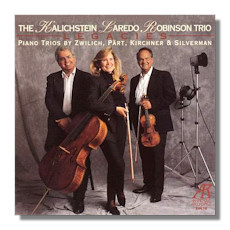
The Internet's Premier Classical Music Source
Related Links
-
Pärt Reviews
Zwilich Reviews - Latest Reviews
- More Reviews
-
By Composer
-
Collections
DVD & Blu-ray
Books
Concert Reviews
Articles/Interviews
Software
Audio
Search Amazon
Recommended Links
Site News
 CD Review
CD Review
Legacies

- Ellen Zwilich: Trio for Violin, Cello & Piano
- Arvo Pärt: Adagio for Violin, Cello & Piano
- Leon Kirchner: Trio #2
- Stanley Silverman: In Celebration
Joseph Kalichstein, piano
Jaime Laredo, violin
Sharon Robinson, cello
Arabesque Z6676
The concept album compiles pieces whose brief life together can seem, like some marriages, a mystery. The five pieces in Legacies qualify for this CD because each has roots in the past. Most musical pieces are melds of originality and influences, yet the pieces on this CD allegedly have more obvious origins. Some subtly use their legacies, others flaunt or satirize them.
Ellen Zwilich's Trio for Violin, Cello and Piano (1987) takes an original approach. It is clever, virtuosic, with flashes of profundity. Through dramatic use of repeats in I, Zwilich forges tension between anxiety and calm. Her legacy in II balances Bartókian eeriness with Shostakovichian melancholy. The players tenuously explore a dark disturbing theme, but never wallow in it. The later part of III treads softly at first, then jumps into playful imitation between piano and strings. The Trio then makes a portentous bow and playfully leaps off the stage with a flourish. Congratulations to Kalichstein, Laredo, and Robinson for their spirited rendition of this piece. It never flags.
The Adagio for Violin, Cello, and Piano (1992) by that morose mystic Arvo Pärt may be less dramatic, but it is still noteworthy. Its legacy is quite specific: Mozart's F Major piano sonata (K. 280). In fact, this work is little more than a palimpsest painted over Mozart's famous adagio movement. Why? What new glimpses does it allow into the heart of Mozart? It overwrites the earlier work's eloquent sense of loss with post-modern angst, the sigh of the weary survivor. The performers slow Mozart's tempo considerably, producing wistful ghosts of his pre-romantic longings. The final note hangs suspended over this secular Dies Irae, a jarring glimpse into Pärt's gloomy world outlook.
Leon Kirchner's Trio #2 (1993) bursts in like a tipsy guest and weaves through jagged sound corridors, abrupt themes, and deceptive quiétude. Its single movement has multiple legacies: meandering expressionism, echoes of Gustav Mahler and Arnold Schoenberg, and swatches of satire. Its patchwork nature ultimately impedes it from being truly memorable. Alas, it has a high tiring speed.
Stanley Silverman's In Celebration (1989) is an engaging classical/jazz cross-over. From its deceptively calm Introduction through its beboppy Kinematic, In Celebration is a sophisticated homage to jazz forms of the past seventy years. The Cantilena-Chaconne is languorous and sly, like an Eric Dolphy rift on saxophone. Jaime Laredo's violin strokes the listener with seductive tones, as if saying, "You like that, huh?" The final movement, Montuno (Rhythmic Song), erupts into a curious amalgam of salsa and spooky dissonance. It ends with a mysterious seven-note ascension on piano.
Copyright © 1999, Peter Bates


















